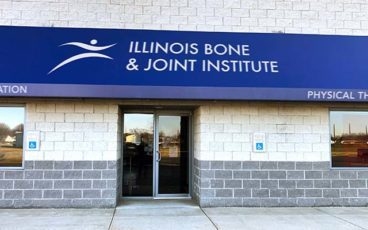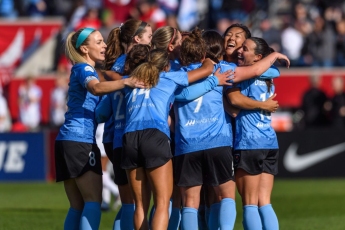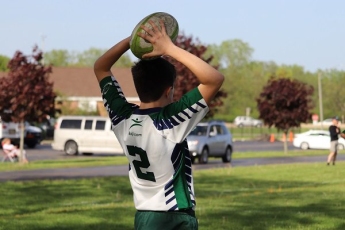Hockey season is in full swing and whether you’re a professional player, high school player, or a parent that has a child just starting their hockey journey, IBJI has all the information you need to know about common hockey injuries. We've got the scoop from Edward Logue, MD, team physician for the Chicago Wolves hockey team. Dr. Logue is an orthopedic surgeon at IBJI who specializes in treating shoulder and knee conditions and general trauma care. He has particular expertise in treating endurance athletes.
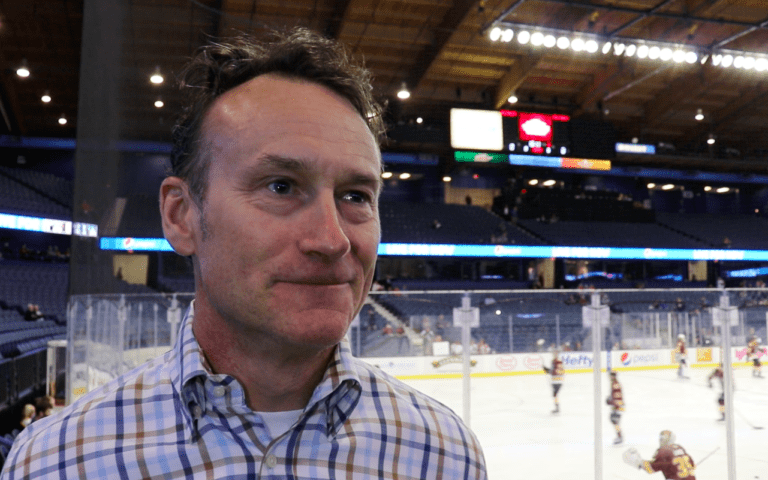
Dr. Logue, team physician for the Chicago Wolves.
How do players get injured?
“The majority of injuries occur due to collisions, either with another player, the ice, the boards, a stick or the puck,” says Dr. Logue.
What are common hockey injuries that you treat?
“Because of the high speed and physical nature of hockey, injuries occur often,” says Logue. “The majority fall into the class of acute injuries. Contusions ranging from simple bruises to major impact injuries, such as shoulder separations, happen daily. Shoulder separations or acromioclavicular (AC) joint sprains are one of the most common hockey injuries. A player is driven into the boards leading with the shoulder, causing the separation. We do see a fair amount of facial lacerations in professional hockey players, which are much less common in amateurs because of face shield rules. Fractures, particularly in the wrists and hands are common, primarily caused by being struck with a puck or slashed with a stick. Concussions are also common due to the physical nature of the game.”
Does hockey have a high risk of injury? If so, why?
Dr. Logue asserts, “The extremely high speed that the game is played along with the physical nature makes injuries much more likely. Add a hard rubber puck traveling at 100 mph and the use of sticks, injuries become inevitable.”
Is it more dangerous for adolescents than professionals?
Risk varies for everyone. Dr. Logue explains, “The sheer size of the professionals makes the collisions that much more impactful and therefore more likely to become injured. Rules in amateur hockey regarding face masks significantly reduces the risk of facial and dental trauma, combined with less tolerance for questionable checking techniques makes it a much safer sport for amateur players.”
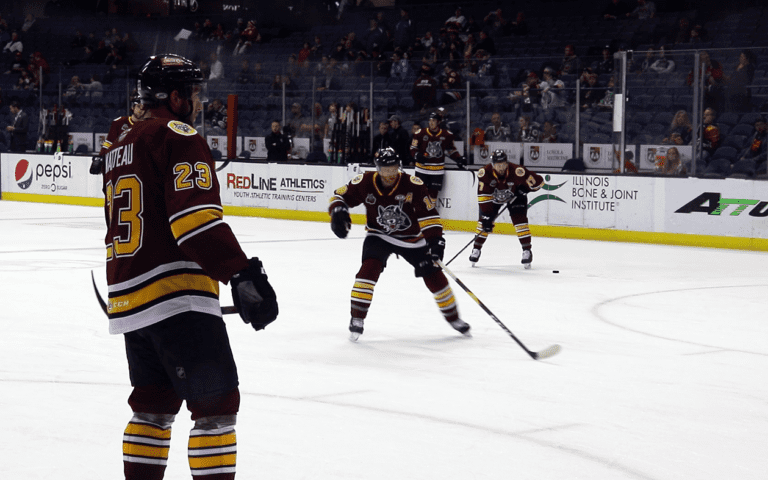
How long can an injured athlete expect to be out of the game?
“This is extremely variable. Most contusion type injuries do resolve fairly quickly, so I’d say the typical injury I see resolves in days to weeks as opposed to months,” says Dr. Logue.
How are injuries treated? What is the process IBJI takes?
“We treat injuries very aggressively. We strive to accurately diagnose the injury right away. At the Chicago Wolves games, IBJI is on-site and we have x-ray equipment at the game for immediate evaluation. On the amateur level, we have OrthoAccess immediate care services and sports medicine clinics to expedite diagnosis. We also have physical therapists at the games and our clinics, so treatment can begin right away. Additionally, our sports neurology team is available for urgent concussion evaluation and treatment.”
What should injured players expect when they return to the game?
“Assuming treatment has been timely and appropriate most players can return and avoid re-injury. Respecting the need for gradual reintroduction to full play to get back up to speed is critical. This is where the coordination of care between players, parents, coaches, athletic trainers, physical therapists, strength coaches and physicians is important.”
How can a player avoid re-injury?
Dr. Logue emphasizes, “Respect the process, utilize the available resources and listen to your body. Appropriate conditioning prior to returning to play makes all the difference.”
Is it important to have a physician at games to quickly diagnose/treat an injury?
“When possible, this makes a big difference both from a safety issue, as well as from the standpoint of expediting rapid return to play. Utilizing services such as IBJI's OrthoAccess or sports medicine clinics can be just as helpful,” says Dr. Logue.
What advice do you have for injured players and parents of hockey players?
“Besides not ignoring warning signs of significant injury such as deformity and limping, my advice is to be patient. You have to give injuries time to heal. I find it much more common at the amateur level for patients to try to rush back too soon in the hope of not missing an ‘important’ game. There is a misconception that the professional hockey players will ‘play through’ an injury and, therefore, so should amateurs. I find the opposite to be true; a true professional will give an injury the appropriate time to heal and, therefore, lessen the risk of re-injury upon return to play. Along the same line is the importance of taking time off after the season is over. Most pros take 2-3 months off from hockey, instead working on general strength and conditioning. At the amateur level, it is hard to resist the plethora of camps and leagues that offer year-round participation, but giving an athlete’s body time to recover and recharge is critical.”
Dr. Logue’s expertise alongside IBJI’s comprehensive and accessible care is here to help guide you down a path to recovery this hockey season. It is important to remember that players are susceptible to injury at any moment during practice and gameplay, so no matter if you play for the Chicago Wolves or your local school’s team, pay attention to your body.
In the event of an injury, you can visit one of IBJI’s OrthoAccess immediate care clinics for treatment. IBJI also offers baseline concussion testing and has an expert-trained sports medicine team to get you or your athlete back to their best on the ice.
Edward Logue, MD is an orthopedic surgeon who specializes in treating shoulder and knee conditions and general trauma care as well as the team physician for the Chicago Wolves Hockey Team. He has particular expertise in treating endurance athletes.
*This content is for information only and is not intended to replace the diagnosis, treatment, or medical advice from your treating healthcare professionals. The content does not provide medical advice, does not constitute the practice of medicine or other healthcare professional services, and does not create a doctor-patient relationship. You should not rely on this information as a substitute, nor does it replace professional medical advice, diagnosis, or treatment. If you have concerns or questions, seek the advice of your healthcare professionals. If you think you may have a medical emergency, call your doctor or 911 immediately. Do not rely on electronic communications or communicate through this website for immediate, urgent medical needs. This website is not designed to facilitate medical emergencies. The use of the information is at the reader’s own risk. The links are provided for information and convenience only. We cannot accept responsibility for the sites linked or the information found here. A link does not imply an endorsement of a site.


